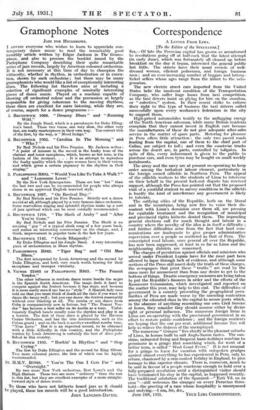Gramophone Notes
JAZZ FOR HMHBROWS.
I ADVISE everyone who wishes to learn to appreciate con- temporary dance music to read the remarkably good monthly article written by Edgar Jackson in The Gramo- phone, and also to procure the booklet issued by the Parlophone Company describing their quite remarkable series of jazz records, largely by American coloured orchestras. It is not necessary at this time of day to champion the virtuosity, whether in rhythm, in orchestration or in execu- tion, shown by such orchestras ; but there may be many gramophonists who would like a list of exceptionally interesting discs. The following list therefore aims at including a selection of significant examples of musically interesting pieces of dance music. Played on a machine capable of showing off orchestral colour and the percussion so largely responsible for giving coherence to the moving rhythms, these discs are excellent for mere listening, while they are, of course, superb for a dance programme :—
1. BRUNSWICK 1068. " Dreamy Blues " and " Running Wild."
By the Jungle Band, which is a pseudonym for Duke Elling- ton's band. These two tunes, one very slow, the other very fast, are really masterpieces in their own way. Tne correct title of the first, by the way, is " Mood Indigo."
2. Baumwtar 1062. " Carolina In The Morning " and " Who ?
By Red Nichols and his Five Pennies. Mr. Jackson writes : " A point of interest in the record is the husky tone of the clarinet and tenor saxophone, which, known as hot tone, is the fashion of the moment. . . . It is an attempt to reproduce the husky quality which the negro women have in their voices, and which gives a certain piquancy to the rhythm in their singing."
3. PARLOPHONE R892. " Would You Like To Take A Walk ? " and " Lonesome Lover."
By the New York Syncope tors. These are less " hot " than the last two and can be recommended for people who always dance in an approved English reserved style.
4. BRUNSWICK 1087. " On Revival Day."
By Red Nichols and his Five Pennies. Strictly not a dance record at all, although played by a very famous dance orchestra. Some marvellous singing and splendid rhythm make up a sort of jazz spiritual which can be most cordially recommended.
5. BRUNSWICK 1104. " The Sheik of Araby " and " After You're Gone."
By Red Nichols and his Five Pennies. The Sheik is an amusing " guy " of a typical sheik song of a few years back, and makes an interesting commentary on the change, and, I think, improvement in popular taste in the last few years.
6. Butrrqsvnex 1145. " Creole Rhapsody."
By Duke Ellington and his Jungle Band. A very interesting piece of orchestration in Blues rhythm.
7. PARLOPHONE R942. " Tiger Rag " and " Old Man Blues."
The first interpreted by Louis Armstrong and the second by Duke Ellington, and both very much worth hearing for their saxophone and trumpet virtuosity.
B. Viczon 22488 or PARLOPHONE R865. " The Peanut Vendor."
The other influence in modern dance music beside the negro is the Spanish South American. The tango finds it hard to compete against the foxtrot because it has steps, and because it is more easily seen if one has no "style." A Spanish lady once told me that you must think of death all the time if you want to dance the tango well ; but you can dance the foxtrot reasonably without ever thinking at all. The rumba or sun dance from Cuba is comparatively new in favour, but " The Peanut Ven- dor " has become a best seller on its merits as a tune. Unfor- tunately English bands usually miss the rhythm and play it as a foxtrot. The first of these discs is played by the Havana Casino Orchestra, and has the true instruments, such as the Cuban gourd ; and on the back is another excellent rumba tune, "True Love." But it is an imported record, to be obtained with a little difficulty in this country, and the Parlophone version by Louis Armstrong is certainly the best of discs pub- lished in this country.
9. Barwswrcic 1105. " Rocklre in Rhythm " and " Stop Crying."
The first by Duke Ellington and the second by King Oliver. Two more coloured pieces, the first of which can be highly recommended.
10. H.M.V. B5968. " You're The One I Care For " and " Overnight." By two more New York orchestras, Bert Lown's and the High Hatters These two are more " ordinary " than the rest in this list, but they are excellent examples of a more straight- forward style of dance music.
To those who have not hitherto heard jazz as it should be played, these ten records will be a good introduction.
JOHN LANGDON-DAVIES.


































 Previous page
Previous page